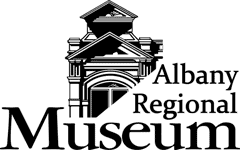By Cathy Ingalls, Albany Regional Museum board member
For anyone interested in Albany’s early history, there’s a gem of a book for sale at the Albany Regional Museum that is a reproduction of the city’s first business directory published in 1878.
The 200-plus-page paperback that sells for $3 contains advertisements, listings of societies and lodges, has a compilation of churches with addresses and times of services, shows names of those living in the city, and notes all of Albany’s “public servants” since the adoption of the city charter in 1865.
And that’s just the beginning of all that’s inside the facsimile.
Near the front, city officials in 1878 are mentioned: the mayor was Jason Wheeler, the recorder J.W. Baldwin, treasurer C.C. Godley, surveyor J.A. Warner, and street commissioner W.J. Mathews. Councilors were Wm. Rumbaugh, Thomas Monteith, Claib. H. Stewart, N. H. Allen, John Brush and George F. Simpson.
Proprietors of businesses are represented in another section with their addresses. They include: Harness makers, George Hobart and Thompson & Irving; druggists, Bell & Parker, John Foshay, Charles Plummer and R. Saltmarsh; and the feed stables were operated by W.R. Cannon, Ans. Marshall and Jason Wheeler.
The locations of all of Oregon’s post offices are included in the book as are the post offices in the Washington Territory. In this part is a helpful explanation of postal rates:
Letters prepaid by stamps cost 3 cents for a “half ounce or a fraction thereof to all parts of the United States; forwarded to another post office without charge on request of the person addressed. If the stamp is omitted, the letter is forwarded to the dead-letter office and returned to the writer.”
Three public schools were operating in Albany in 1878.
Children living from Ferry Street west attended the Seventh Street School taught by Miss Maggie Irvine; those between Ferry and Railroad streets went to Central School, presided over by Professor D.V.S. Reid assisted by Miss Estella Howard and Miss Ella Hunsaker; while all of those living below Railroad went to Dixie School taught by Miss Maria G. Irvine.
Directors of the school district at this time were Dr. J.L. Hill, D.M. Thompson, and L. Flinn, while John H. Burkhart was the district clerk.
School property was valued at $7,000, funds received during the year were $3,575.14, and teachers’ wages and repairs were $1,115.67.
In another part of the book is an index of city laws, that includes the powers of the city council, the granting and collecting of licenses, the taxing of dogs, naming streets, rules relating to prisoners working on streets, the hitching of animals to shade trees, and the appointments of police and a night watchman.
The rules governing the administration of the fire department are quite precise.
For example at board of delegate sessions, the president shall preside at all meetings, shall preserve order and decorum and enforce a strict observance of the law of the department and the rules of the board.
The president shall call special meetings when requested in writing by four members or when notified by the secretary of the suspension of an officer or company, or whenever he may deem necessary.
In 1878, Joseph Webber was the fire department’s chief engineer and M.S. Monteith was the assistant engineer.
The directory brags that “our fire department though small is well regulated and very efficient, which is due in a great measure to the efforts of Joseph Webber, who has had many years of experience in fire matters.”
The section goes on to say that the city is well provided for “in the way of water for the use of the engines. Besides eight large cisterns located at different points, several races and flumes traverse our streets from Eighth to the banks of the Willamette and can be used for fire purposes at any point.”
Here are some examples of advertisements appearing in the front of the directory:
Scott & Monteith’s sportsmen’s emporium at 124 Front Street was “importers and dealers in guns, rifles and revolvers of every description.” Also on sale were fishing tackle, fancy goods, beads, baskets, birdcages and croquet games. The business also repaired sewing machines.
W. H. Brunk, no address listed, manufactured the “very best” boots and shoes in Albany and guaranteed perfect fits and low prices.
Conrad Meyer operated the Star Bakery at Broadalbin and First streets and dealt in groceries, crockery, glassware, bread, cakes, pies, cigars and tobacco.
Ans. Marshall was the proprietor of Fashion Stables that featured “the best turn-outs in the city. When you want a good rig, be sure to call at the Fashion Stables at the corner of Second and Washington streets.”
F. S. Dunning was a wholesale and retail dealer in furniture, and undertaking was a specialty. “Rosewood caskets and coffins always on hand.”
The facsimile of the 1878 directory was printed probably in 1978 and was commissioned by Tripp & Tripp Realtors, the “pioneer real estate firm in the Willamette Valley.” It is thought that the book was used for business promotions.
Hours to purchase the book at the museum, 136 Lyon St. S. are 11 a.m. to 4 p.m. Tuesday through Friday and 10 a.m. to 2 p.m. Saturday. For more information, call 541-967-7122 or visit online at www.armuseum.com.
